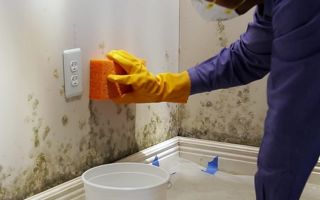Content
- 1 Why does mold appear in the apartment
- 2 How to remove fungus on the walls in an apartment using folk methods
- 3 How to remove mold in the house with pharmaceutical products
- 4 How to remove mold with specialized tools
- 5 How to remove mold from various surfaces and places
- 5.1 How to remove mold from the walls in an apartment
- 5.2 How to remove mold from the ceiling
- 5.3 How to remove mold from wallpaper
- 5.4 How to remove mold on windows
- 5.5 How to remove mold from your closet
- 5.6 How to remove mold from linoleum
- 5.7 How to remove mold on the balcony
- 5.8 How to remove mold from wood surfaces
- 6 Preventing mold
- 7 Conclusion
It can be very difficult to remove fungus on the wall in an apartment, but there are many methods for removing mold. To get rid of ugly and dangerous stains in the house, you need to know how to fight fungus and preventative measures.
Why does mold appear in the apartment
At first glance, it seems that in an ordinary apartment building, mold should not occur in principle. People are used to believing that the fungus reproduces mainly in private and at the same time very neglected houses.
In fact, this is not the case, mold can appear even in the most comfortable, beautiful and stylish city apartment. There are several main factors in its occurrence.
- Poor ventilation and high humidity... If fresh air practically does not enter the apartment, then sooner or later excess moisture begins to accumulate on the walls and in the corners. This environment is ideal for mold growth.
- Constant moisture leakage, usually against this background, mold occurs in the kitchen or in the bathroom with faulty faucets. In the upper floors, fungus can develop on the ceiling and in the upper corners if the roof is leaking.
- Too strong freezing of the walls, windows and other structures in the winter. If a wall with a window or window slopes are cooled too much, then in contrast to room temperature, condensation forms on their surface. If walls or slopes "fog up" constantly, then sooner or later mold will start on them.
Whatever the cause of the fungus in the apartment, you need to think about how best to remove the mold from the walls. Mold not only spoils the interior and gradually destroys surfaces, it is dangerous for the human body. With permanent residence in an apartment with mold, allergic reactions and dermatological diseases can develop, against the background of high humidity, ailments of the respiratory system occur. In adults, and especially in babies, immunity drops sharply.
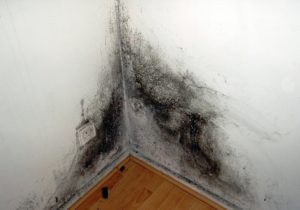
How to remove fungus on the walls in an apartment using folk methods
If a fungus is found in the apartment, and specialized tools are not at hand, then you can remove black mold from the walls with home remedies.
- With vinegar... The liquid must be drawn into a spray bottle or moisten a rag in vinegar, and then wipe or thoroughly spray the affected surface. Then a section of the wall is wiped with a cloth moistened with plain water, and the room is properly ventilated, the vinegar emits a rather pungent odor.
- Using tea tree oil... For 200 ml of water, add 7-10 drops of oil, and then spray on the surface or moisten a rag in the solution. You can also lay out cotton pads soaked in essential oil in the room and light an aroma lamp. A few minutes after applying the ether, the wall should also be wiped with a damp cloth and left to dry.
- With soda... An alkaline environment is detrimental to any fungus.In a glass of water, you need to dissolve only 1 spoon of powder, and then moisten a sponge or rag in a soda solution and thoroughly rinse the wall.

How to remove mold in the house with pharmaceutical products
In addition to home remedies, cheap pharmaceutical preparations help to cope with mold.
- Ammonia... Ordinary ammonia must be diluted with water in equal amounts, and then treated with the affected surface. In this case, some rules must be observed - processing is carried out only with gloves, it is also advisable to wear protective glasses. After wiping the wall with ammonia, it will need to be thoroughly rinsed with water to eliminate the pungent odor.
- Boric acid... The solution has a good effect even when used alone, but it works even better in combination with vinegar and hydrogen peroxide. Acid, vinegar and peroxide must be mixed in a 1: 2: 2 ratio, and then diluted with 4 more parts of water.
- Hydrogen peroxide... Ordinary peroxide has powerful antibacterial properties and kills fungus. With a pharmacy 3% solution, you need to properly treat the contaminated surface, and then lightly rinse the wall with water.
Peroxide is the best choice for uneven old walls. It is safe for health, and even if the remains of the product cannot be removed from the surface of the wall, there will be no harm from this.
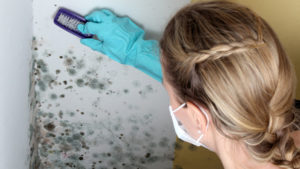
How to remove mold with specialized tools
If the wall is heavily infected with mold, it makes sense to use specialized chemicals. The effect from them will be faster and stronger than from home and pharmacy remedies.
- Washing powder or bleach... Aggressive substances in the composition allow you to quickly remove the mold with whiteness or powder. Household chemicals are diluted with water, and then liberally applied to the wall with a stiff brush. The wall is then washed thoroughly and left to dry.
- Copper sulfate... This chemical is fungicidal and works well against mold, and you can buy it at any hardware store. About 20 g of powder should be diluted in 1 liter of warm water and the desired section of the wall should be treated with the solution several times - with an interval of 3-5 hours between procedures. First, the wall must be properly cleaned with sandpaper and washed with soapy water. Copper sulfate is used only in protective gloves and a mask, and the room after processing is properly ventilated.
- Ready-made fungicidesfor example, Fongifluid or Senezh Effeo. These solutions are designed specifically to remove fungus in the house on the walls, and give a guaranteed result. The chemical agent must be applied to the wall 1 time, and when it dries, remove the dry residue of the solution with a stiff brush.
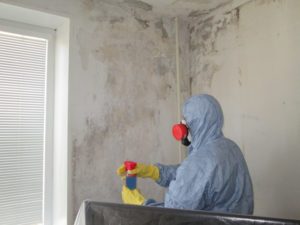
How to remove mold from various surfaces and places
Mold in the apartment can appear not only on the walls, but also in other places. In general, it can be derived using the same methods, but it is necessary to take into account certain nuances.
How to remove mold from the walls in an apartment
Homemade and specialized remedies reliably kill mold. But if the wall is treated incorrectly, then soon the mold may grow again.
- To remove the fungus from the walls in the apartment, it is not enough just to wipe the infected area with ammonia, vinegar, bleach or other solution. It must be borne in mind that fungal spores penetrate deep into the surface.
- For this reason, it is recommended to carry out antifungal treatment of the wall 3-4 times in a row, that is, apply the fungicidal agent in layers, waiting for the previous layer to dry.
- Ideally, you need to process the wall for a couple of days, then the effect will be guaranteed.
To remove the fungus from the wall completely and completely, you need to process not only the area with dark spots, but also the neighboring places, even if at first glance they are completely clean.

How to remove mold from the ceiling
In an unfavorable microclimate in an apartment, mold can appear not only on the walls, but also on the ceiling. They remove the fungus using traditional methods - using home or special means. But there are also some peculiarities.
- If the ceiling is whitewashed, painted with paint or covered with wallpaper, then mold can be removed from it only after removing the top layer of the decorative surface. In case of complex infection with a fungus, the wallpaper will have to be removed, the paint removed with a solvent, and the whitewash must be cleaned off in the right places. The exposed ceiling is treated with a fungicidal solution several times and the area is allowed to dry to the end. After that, the whitewash or paint is renewed, and the wallpaper is pasted again.
- If the ceiling is stretched, then it is necessary to remove the fungus on the ceiling in the room without dismantling the ceiling itself. The fungicide is simply sprayed over the surface with a spray bottle or spread with a sponge, and then washed and wiped off the ceiling with a dry cloth.
Mold on PVC stretch ceilings occurs most often due to lack of ventilation. To prevent it from reappearing, it is necessary to pay special attention to the prevention of fungus.

How to remove mold from wallpaper
It is very difficult to remove mold from wallpaper without damaging the decorative surface. If the wallpaper is old, it is much easier to remove it, treat the wall from the fungus and stick new wallpaper. But if the mold has arisen after a recent renovation, then it makes sense to remove the fungus without redoing the interior.
If the wallpaper is paper, then you must try to remove the fungus "dry", you cannot wet the coating. To do this, the wallpaper is first properly dried with a hairdryer or ironed with a hot iron, and then simply cleaned off the ugly dark spots from them. It should be noted that this will take a lot of time, and the result will be questionable - firstly, the stains may not completely go away, and secondly, mold is likely to reappear.
If the wallpaper is non-woven or vinyl, then you cannot heat them. But on the other hand, the waterproof coating can be treated with standard antifungal solutions, the main thing is not to overdo it with the amount of liquid and use only a soft brush for processing.
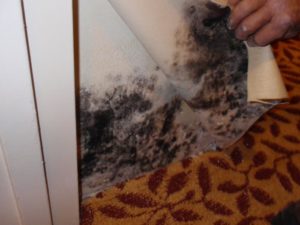
How to remove mold on windows
Mold on frames, slopes and window corners occurs when the temperatures of the window and the interior are too different. This leads to the formation of permanent condensation, which is why the fungus occurs.
Plastic slopes on windows can be treated with any of the listed antifungal agents. To avoid the further appearance of mold, the slopes in the slopes should be filled with sealant, it will help to reduce the temperature difference in the window area.
Wooden windows require a particularly careful treatment, since mold penetrates deep into the structure of the tree. To remove mold, use any means that do not leave a too pungent odor. After processing, the window is thoroughly dried with a hairdryer, but you cannot direct hot air onto the glass itself - it may burst.

How to remove mold from your closet
Fungus can appear in the closet, especially if the closet is wooden, and clothes get slightly damp from time to time.
- To remove mold from the closet, first of all, you need to remove absolutely all clothes from it and temporarily put it in closed plastic bags, then mold spores will not spread to furniture and walls.
- Then the cabinet must be thoroughly treated with antifungal agents from the inside and dried thoroughly for several days. It is best to use gentle, odorless solutions - soda or hydrogen peroxide.
To remove mold forever, things will need to be completely washed and dried thoroughly before putting them in the closet.
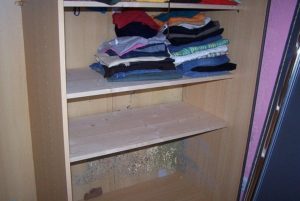
How to remove mold from linoleum
With high humidity in the apartment, even linoleum can become moldy in the corners. If the coating is quite old, and the fungal infection is extensive, then it is better to completely remove the linoleum, clean and disinfect the rough surface with high quality, and then put a new coating.
But if the linoleum is new, and you don't want to change it, then you just need to properly treat its outer surface with fungicidal agents. Particular attention should be paid to places in the corners and near the walls, it is better to remove the baseboards during work and also clean them so that the fungus does not remain in hard-to-reach areas. To remove black spots, linoleum can be rubbed with a brush, but gently so as not to damage the coating.

How to remove mold on the balcony
To remove mold from the balcony, it is necessary to completely clean the space of all things and carry out a thorough treatment with antifungal solutions. The balcony should dry out for several days, the walls and corners can be warmed up with a hairdryer. If the mold has managed to capture not only the outer surfaces, but also the insulating materials, they will have to be replaced, otherwise the fungus will return again.
Since mold on the balcony occurs when there is waterlogging, it can be removed only by removing excess moisture. To do this, you will need to seal up all large cracks with cement mortar, treat the surfaces with an antiseptic primer and equip waterproofing in all places where excess moisture can get from the street.

How to remove mold from wood surfaces
A wooden floor or other surface will have to be treated very carefully. To remove mold, you need:
- treat the tree with soapy water;
- with a sharp tool, carefully scrape off the top layer of the surface along with the fungal infection;
- dry the tree with a hairdryer;
- sand the remains of dark plaque;
- soak the tree with an antiseptic and dry it again.
When the surface is completely dry, it will need to be sanded. Then it is recommended to treat the tree with a waterproof varnish, it will prevent the new appearance of the fungus.

Preventing mold
Preventing the occurrence of fungus is much easier than removing mold on the walls of an apartment. As a preventive measure, it is necessary:
- regularly ventilate the apartment and prevent high humidity;
- monitor the condition of the ventilation holes and, if necessary, call specialists to clean them;
- leave plastic windows in the minimum ventilation mode even in winter for fresh air access;
- do not put furniture close to walls;
- timely repair leaking pipes and taps;
- often leave the door to the bathroom open;
- do not put wet clothes in the closet;
- if possible, do not dry a large number of wet things in the apartment.
In the process of cooking in the kitchen, it is necessary to open the windows - at such moments, not only the temperature in the room rises, but also excessive humidity arises from the water vapor rising from kettles and pots.
Conclusion
You can remove the fungus on the wall in an apartment in dozens of different ways, with home and professional means.But it is much better to monitor the level of humidity in the room and regularly arrange ventilation, then mold, in principle, will not appear on the walls.

